
Q & A with artist Sean Ferris
Published July 23rd, 2025 by Blaine Garrett
Heavily influenced by the aesthetics of punk show flyers, cartoons, and absurdity, artist Sean Ferris talks about his move to Minneapolis, how he developed his distinctive style, and how his artistic exploration intertwines with his mental health journey
I had a professor in college who was adamant that we not use the term "explore" when writing about our art. Their argument was that artists are communicators and craftspeople — bringing ideas into the world, not researchers out discovering things that already exist. I don’t fully agree, but I do occasionally cringe when I read an artist statement where the artist is "exploring" this thing or that thing. It often feels like a buzzword that allows the artist to avoid committing to a clear purpose for their work. However, sometimes that purpose is exploration—especially of the self. Art can be many things, but it can also be a therapeutic tool to help us figure out who we are and to communicate in ways that are hard to articulate with words. One such artist using his work in this way is Minneapolis-based Sean Ferris. I’ve been in awe of Ferris’s art since he contributed to the MPLSART Sketchbook Project in 2020, and I’m excited to finally sit down and talk with him about punk flyers, beehive hairdos, and using art as a tool for healing. Enjoy. ~Blaine
Artist Sean Ferris lives and works in Minneapolis, MN. He paints with inks to explore his personal struggles with mental health, upbringing, sexuality, and identity. Playing on themes of everyday experiences, memories, and fantasies — mixed with overheard, embellished, and closed-door conversations, he creates unfinished sketches. These sketches, sometimes paired with dialogue and cryptic notes, attempt to push a sense of haste, spontaneity, and motion through still images.
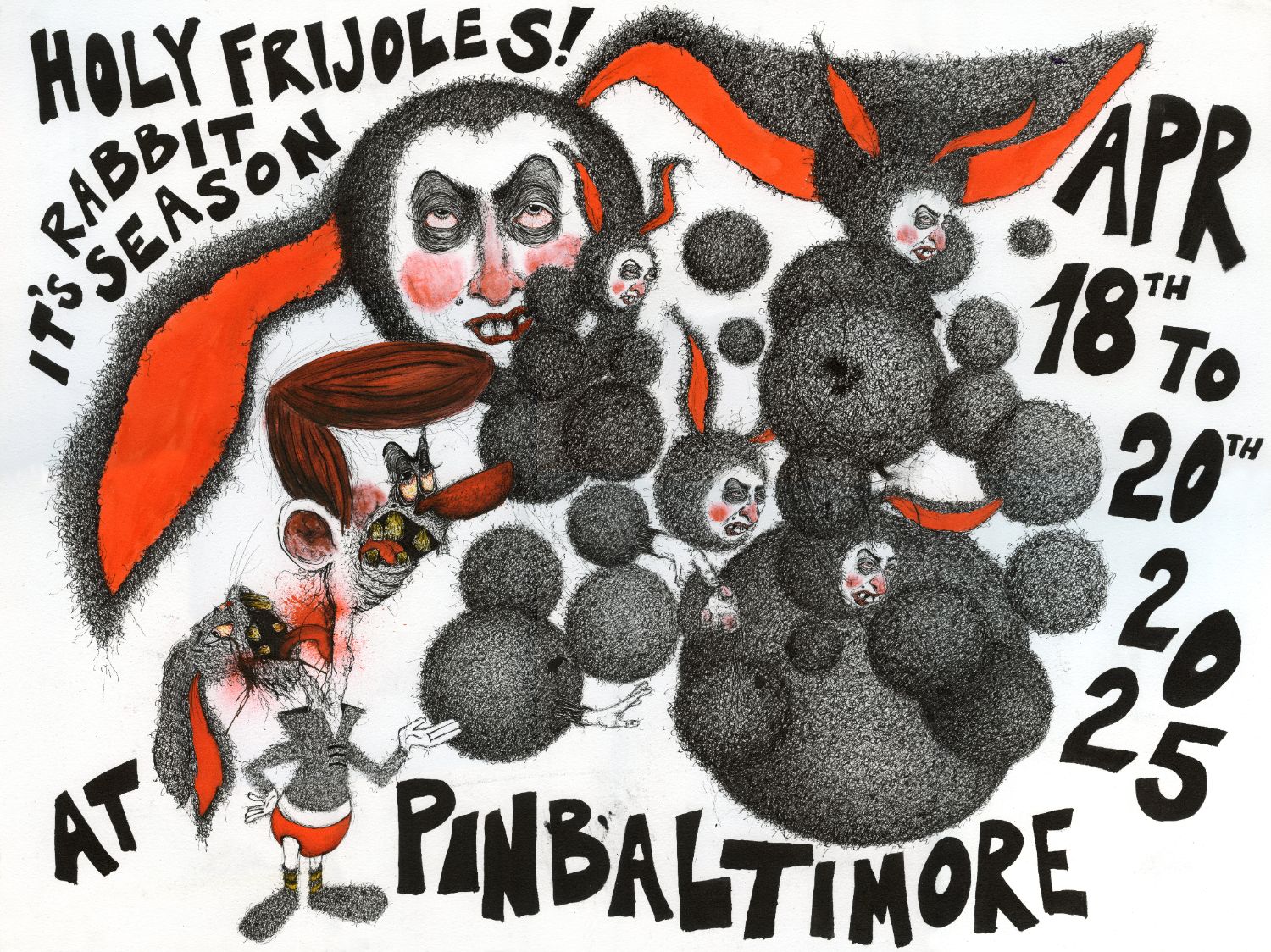
Pinbaltimore, ink & coffee on paper, 22" x 30", 2024
Blaine Garrett: As someone relatively new to the Twin Cities, what brought you to Minneapolis?
Sean Ferris: I grew up in Pittsburgh most of my life but I spent time living in Oregon and Texas, too. During my years at the University of Pittsburgh, I was able to study abroad in France. After college, I returned to France to work on a farm for a bit. Those experiences made me think more about leaving Pittsburgh for good. Studying and working in France and being forced to speak a new language had a big impact on me, and I still use the language in my work at times, especially when I want to be more cryptic about what I’m saying.
I finally left Pittsburgh for Minneapolis in 2017. At the time, I was married and came here because my (now) ex took a job opportunity in St. Paul teaching art at an elementary school. We were both looking for a change of atmosphere from Pittsburgh, so we took a chance and moved to Minneapolis. Prior to the move, I really didn't know anything about the Twin Cities, and I'd never even visited before.
BG: Wow, that's a big leap of faith. What has your experience been like as an artist in Minneapolis? Have you found your people?
SF: At first, I didn’t know anybody here. I was renting in Northeast and I was lucky to have good neighbors. Mainly, I would hang out with them. The neighbors on one side of me were also artists, and I lived close to the California building and Casket Arts so I had a good introduction to the art scene.
The pandemic happened just when I was starting to branch out a little and meet more people so that put a delay on all that. However, a few months into the pandemic, I contributed drawings to the MPLSART Sketchbook Project. Through that, I’ve made friends with a good crew of like-minded artists and weirdos. I feel that I’ve finally come into my own here and really feel welcomed and encouraged in the local arts community.
Also, moving to Minneapolis has increased the work I do now. Part of that was because, at first, I didn’t have a job and didn’t really know anyone. This gave me a lot more time to concentrate on my work. I also didn’t have any baggage here and felt more free to create things and express myself without holding back. This was well received and gave me more confidence to continue with the style and subject matter.
I have my own house now in Longfellow that has a home studio to work out of. Minneapolis has been a great fresh start for me and I feel fortunate to be in the place I’m at with the friends I’ve made here. All this has given me more of a feeling of the fact that I really live in this city and can call Minneapolis my home now.
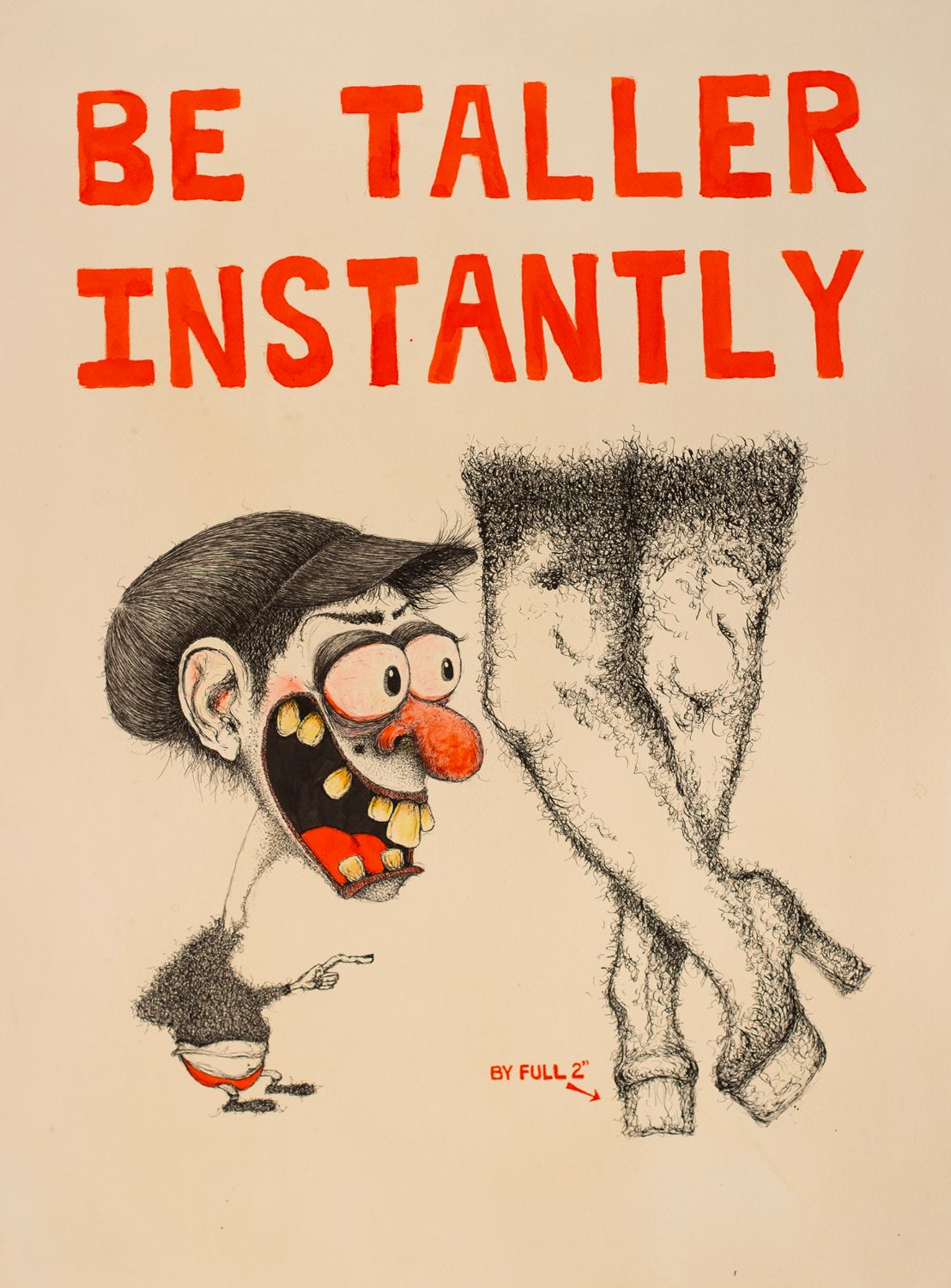
Be Taller Instantly, inks & coffee on paper, 22" x 30", 2023
BG: What media do you typically use?
SF: I prefer using inks on paper and sketching with pens in my sketchbook. If you make a mistake with inks, you have to just kind of deal with it. You can’t erase it. You can't go over it. You just have to turn it into something whether you like it or not. That can change what direction the drawing goes in.
Sometimes I’ll stain the paper with coffee. It gives the paper this nice light brownish splotched look. It’s not evenly distributed and there’s an irregularity to it. Like the mistakes with the inks, you don’t know what it’s going to look like until you do it. I don't use coffee to make the drawing look old or antiqued or anything like that. It’s more that the blank white paper looks too clean and crisp and daunting. After I stain it with coffee, I’m no longer worried about messing up a $10 sheet of paper — it's already "messed up." Also with the type of paper I use, I like to draw with an anti-feathering black ink a lot since this ink holds better to the paper and has a smoother movement, especially when drawing fast or making fine lines like when drawing hair. Without putting the coffee down first, it can feel like I’m almost scratching the paper.
Recently, I’ve been getting back into screen printing too and joined Supercharged Printmakers in the Casket Arts Building. I had some experience with screen printing 30 years ago and it’s been kind of a nice break from my regular ink drawings. When I’m having creative block or am stressed or down about what I’m working on, screen printing has been a great distraction to just play around and not worry about the outcome. From there, I’m usually able to finish my drawings and get around the blocks.
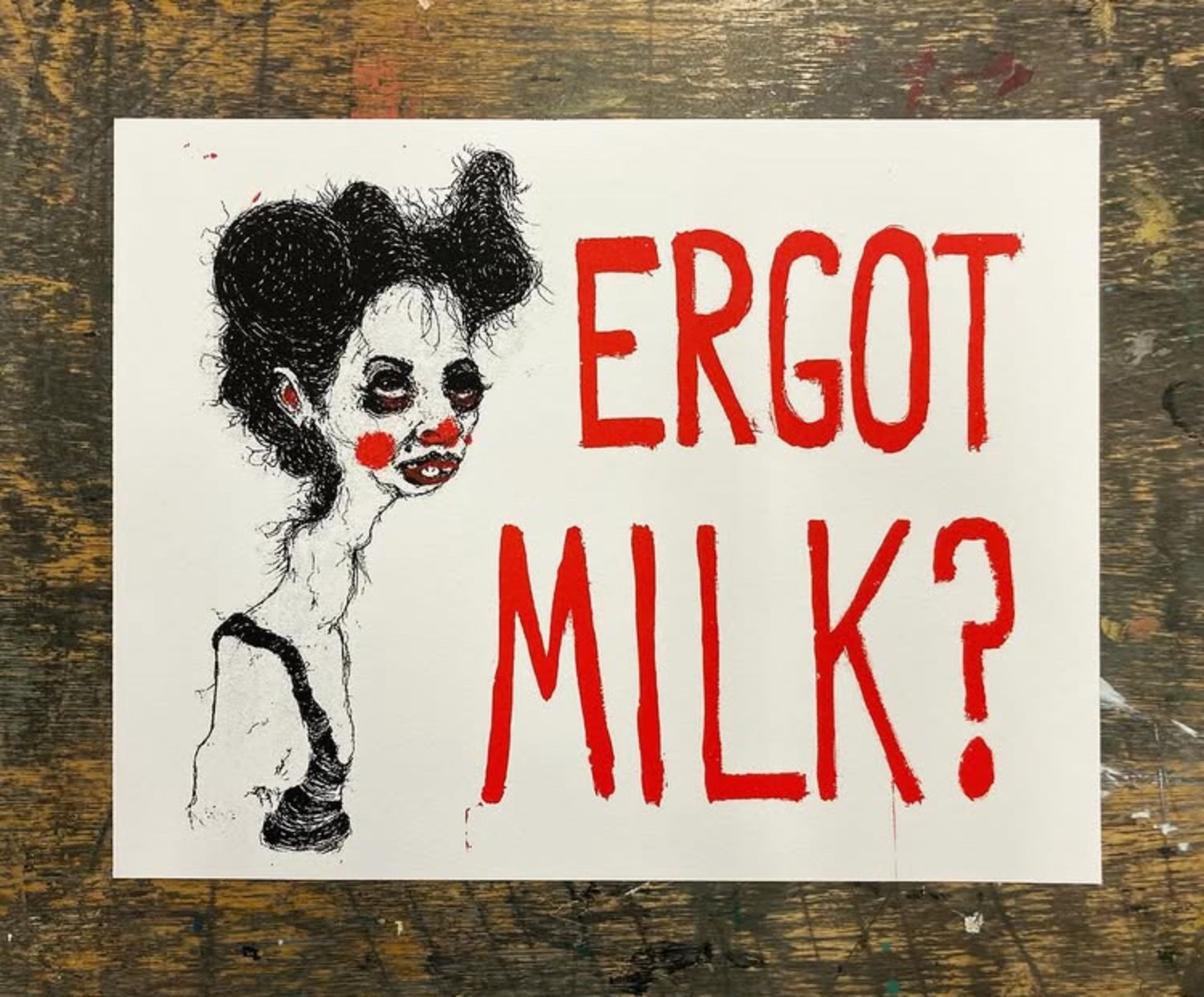
Ergot Milk?, screen print on paper, 8.5" x 11", 2024
BG: I love that your work has a lot of dark humor and irreverence to it. What are some of the influences driving the content of your art?
SF: I’ve always been very taken by the idea and philosophy of the absurd. Even from an early age, nothing around me nor the people in my life made a lot of sense to me. Everything always just seemed arbitrary and made up. Things like with social norms and such. You know, expectations of how you should be and what you should want and value out of life. It was just never for me, at least the things that I saw around me.
I would spend time growing up at my grandma’s house where my uncle lived as well. This is where a lot of my early influences that continue today started. My grandma would watch soap operas and my uncle would listen to oldies from the ‘50s and early ‘60s. These would both be on in the same room at the same time at full volume. So I was bombarded with these sounds and visuals of absolute over-the-top drama. The music was all about devastating unrequited love and all the emotional pain. The soaps were all about affairs and corny acting. I just took it all in at an early age and saw how funny "the serious" could be. That’s probably where I began thinking about absurdism.
Along with those influences, I became infatuated with the ridiculous worlds of Hanna-Barbera and Looney Tunes cartoons and eventually Ren and Stimpy. I learned to draw from Hanna-Barbera at an early age. The posture of the faces was something I could copy and understand how to replicate. It has a very distinctive simplified style. There are only three angles of the face — straight-on or slightly left or right but with both eyes showing. The body is similar but mainly slightly left or right.
I took a lot more of the humor from Looney Tunes and Ren and Stimpy than the drawing style. I still borrow things from them and draw Bugs Bunny frequently, but I think the content was more of the influence there. Same with reading Mad Magazine. I had access to lots of Mad from the ‘70s. I also took the humor more from that than a specific drawing style. Although, anytime I am drawing a straight-on portrait, whether trying to be more realistic or cartoony, I feel like I’m always just drawing a variation of Alfred E. Newman. He is always portrayed as a front portrait no matter the scene. So that must have gotten in my head at some point.
As I got a little older, I stumbled upon old punk flyers from Black Flag by the artist Raymond Pettibon. The pairing of words with my drawings come directly from the style of these flyers. They also introduced me to an almost spoof advertisement style. They were obviously promoting the bands’ shows but they were done in a way that was humorous and dark. Also being photocopied, it had the feeling that art doesn’t have to be pure and perfect. Words were seemingly sorta just thrown onto Pettibon's art. It wasn't balanced with the rest of the page and was loose and seemed quickly put together the night before. This gave me comfort knowing that I could do the same with what I wanted to draw.
Later on, I discovered artists like Degas and Toulouse-Lautrec where I could use my cartoon-influenced style to create fake posters and ads with a sense of seriousness and delicateness while maintaining an absurd character.
A good example of all those influences coming together is Beach Beauties. It has elements of the soap operas, the ‘50s/60s bands, the cartoons, the punk flyers. The poses of the characters are based on a still I took of Fred Flinstone and The Great Gazoo looking at each other.
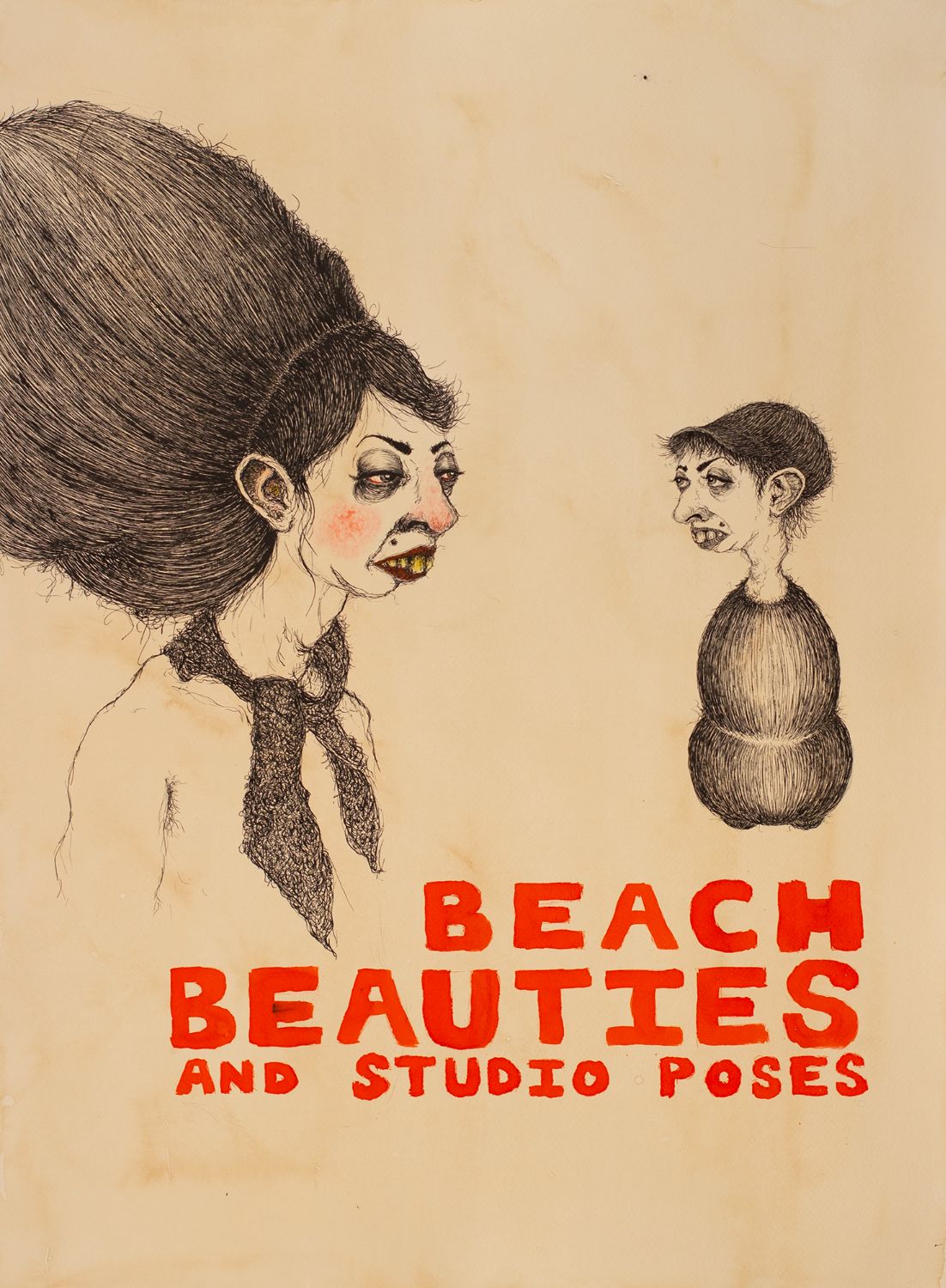
Beach Beauties, inks & coffee on paper, 22" x 30", 2023
BG: In addition to the punk flyers, how does music shape your work? What do you listen to while you're drawing?
SF: I actually don’t listen to music while I’m drawing. It's the only time I’m able to focus and really be present. However, when I’m not drawing, I have music playing all day. All that oldies music I listened to growing up shaped certain things about my work such as the hair styles I’ll draw. I like a beehive hairdo here and there. Sometimes the general feeling of a character or the drama surrounding them is influenced by the music.
I also grew up listening to all those early California punk bands like the Dead Kennedys and the Keith Morris era of Black Flag. I channel their short fast accessible songs when I’m just trying to get ideas out quickly and it allows me to work fast over and over again without worrying about how the drawing is going to turn out.
After being obsessed with the design of punk flyers in my youth, I had the opportunity to make one myself for the band OFF! which was Keith Morris’ most recent band. The flyer was for the Kansas City stop for their Free LSD album tour. They put out a request for artists and ended up using one of my pieces for that show. Having my art used as a flyer for a band that I really admire and that influenced my art really was a full circle kind of thing.
I think some of the other music I got into like ‘90s noise bands like The Jesus Lizard and Shellac when I was an early teen further cemented this idea of the absurd in life and art. The Jesus Lizard was a wild band to see in the ‘90s with David Yow leaping into the crowd or off balconies and singing in the pit. It showed me that being an adult could mean a much different thing than the stereotypical view. This was a time in my life when I regularly took acid and skateboarded. So instead of maybe someone listening to Pink Floyd while tripping, I would listen to Shellac and Don Caballero. This all fed into a realizing that everything (societal expectations, norms, etc) is just bullshit and you can do whatever you want, including being an artist. Also, I remember getting Shellac’s album At Action Park and the album sleeve was just a piece of cardboard and had silver or foil-like printing on it. This was like a new version of those punk flyers to me. I was doing screen printing in high school at the time, and it was just another situation of "I can do that."
I still listen to a lot of these same bands, and Shellac remains my favorite. The repetitiveness of the music and seeing these amazing bands in small clubs as a teen definitely all show up in my art in some way or another blatantly or otherwise.

Pizza Boy sequence excerpt, 12" x 9", 2025
BG: Pizza Boy is the star of your latest book. This is just one of a pantheon of characters represented in your work. How do you come up with your characters and what do they represent?
SF: In one way or another, my characters usually have something to do with a particular part of me. Pizza Boy, for example, is a character I’ve been drawing for a few years now. It’s a way of dealing with certain traumas I experienced as a kid. I experienced some neglect and was around a lot of unsafe adults when I was young. I can take a lot of feelings and pack them into one character to then own the feeling surrounding it tangibly on the page. By bringing Pizza Boy into existence, I'm able to express feelings that I can’t really articulate otherwise. I can draw on situations where I felt both safe and unsafe and put some type of closure to it. Everything with the Pizza Boy character is symbolism that I understand but it’s not necessary for a viewer to comprehend. The viewer can take whatever they get from the work. I don’t like to completely explain my work and prefer it to be cryptic and ambiguous. This allows me to be more free to express myself and put down my thoughts and feelings. I like my art to stand on its own without needing explanation.
That being said, I can allude to some symbols of the character’s look. The beehive hairdo comes from ‘60s girl bands like The Ronettes. The fuzzy sweater comes from a particular living room couch I liked that was almost a faux black long fur. The yellow and black socks represent Pittsburgh. Pizza is a comfort blanky-like object — something tangible to have. The whole general look of the character also is made up of a kind of Mickey Mouse character. The beehive is the large mouse ears, the fur-like black torso is there, the red shorts, and the yellow shoes.
Some of the character’s feelings come from the Looney Tunes of the angel and devil on someone’s shoulders. It’s mixed with a lot of emotions and situations. Some good, like being with my uncle listening to old 45s while he chain smoked Camel non-filters. Some bad, like being left alone at a very early age.

Winston Tastes Good, Ink & coffee on paper, 22" x 30", 2024
BG: How has your artistic practice supported your mental health journey?
SF: It’s everything. It’s my main form of coping. I can get out everything I’m feeling. I have a diagnosis of Dissociative Identity Disorder (DID) and depression, and I can have audio hallucinations.
DID is something that is really misunderstood and there is a lot of stigma associated with it. It used to be referred to as "Multiple Personality Disorder" and that has been blown up to mean having all these different people in your head that you can become. But that view of DID comes from movies like Sybil which was later revealed as a fictional account. It’s very rare for someone to have such distinct personas act out like that. So sometimes I am weary of talking about DID because of incorrect preconceived notions.
Really DID is just kind of like the brain compartmentalizing. I dissociate in situations when I feel unsafe. For example, I might not hear or notice someone yelling at me. A part of the self takes over and blocks that out. My personas are all me. But each one needs its time and space. Instead of them all coming together as one, they are separate for me. Also I can go into severe depression and have spikes of mania.
Drawing doesn’t make these things go away. There is no cure. However, drawing is a way I cope with them. It’s a way to let a part of self have its space and time to be. It's a way to put down anything while depressed. It’s a way to corral racing thoughts. It’s a way to allow the sounds and yelling to be directed towards something. It’s a way to not follow down and get hooked with intrusive thoughts. It’s the best therapy for me.
Pizza Boy is an example of a lot of those states of mind. Two particular examples of drawing Pizza Boy is coping with intrusive thoughts and giving a part of self its time and space. For intrusive thoughts, a way I cope is to acknowledge the thought but don’t let myself get hooked by it. By this I mean, I say out loud or to myself, “There’s a thought,” and I repeat that over and over after each time the thought comes up. Eventually the brain gets bored with the thought because you aren't chasing it, and the thought just floats away. It’s like when you fall asleep. You don’t know the exact moment you fall asleep, but you do. Same with the intrusive thought, you don’t know when it goes away, but it does.
I use this coping skill with drawing. For Pizza Boy, I have drawn about 240 figures for the book and over 500 in general for this project. By drawing this over and over again in a sort of sequential animation stills, the part of self gets its time and the intrusive thoughts surrounding it slowly disappear because my brain is getting bored. So I can take all the feelings around it and come to some kind of closure or acceptance and move on. Not that it goes away for good. But it is extremely helpful.
I also go to therapy weekly and take medication as well. Sometimes, I have a hard time articulating things and I forget words and generally how to communicate, both in therapy and in life generally. So instead, I can show my therapist drawings to explain how I’m feeling. I do this outside of therapy as well. I draw and share online or give drawings away to friends. The drawings may be extremely cryptic or not, but it's a form of communication for me. Instead of saying how I’m feeling, I can express it through my work. I feel like I get my point across and am understood.
I try more and more to discuss these things to remove the stigma with mental health, but I usually won’t bring them up unless asked directly like now. But I feel I make it well known in my art. At least hinting at it.
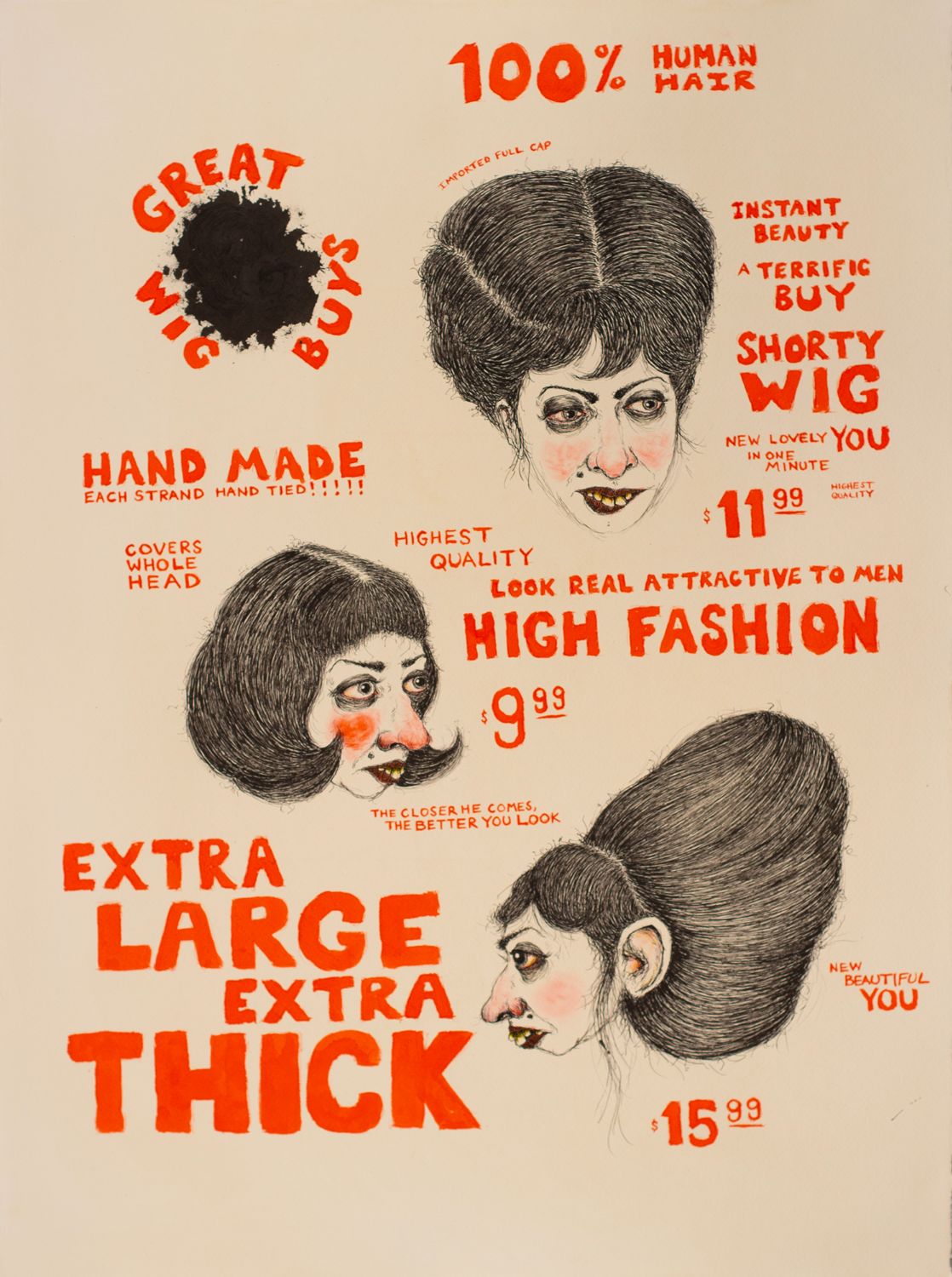
Great Wig Buys, inks & coffee on paper, 22" x 30", 2023
BF: How can folks reading this best support you and your work right now?
SF: I finished this Pizza Boy project and made it into a book with all the sequential drawings. It's available on my site. I'm selling it at cost for $15. I also post sketches, screen prints, and final drawings on my IG account: @seanandferris. You can buy my art directly from me. Just inquire. ◼︎
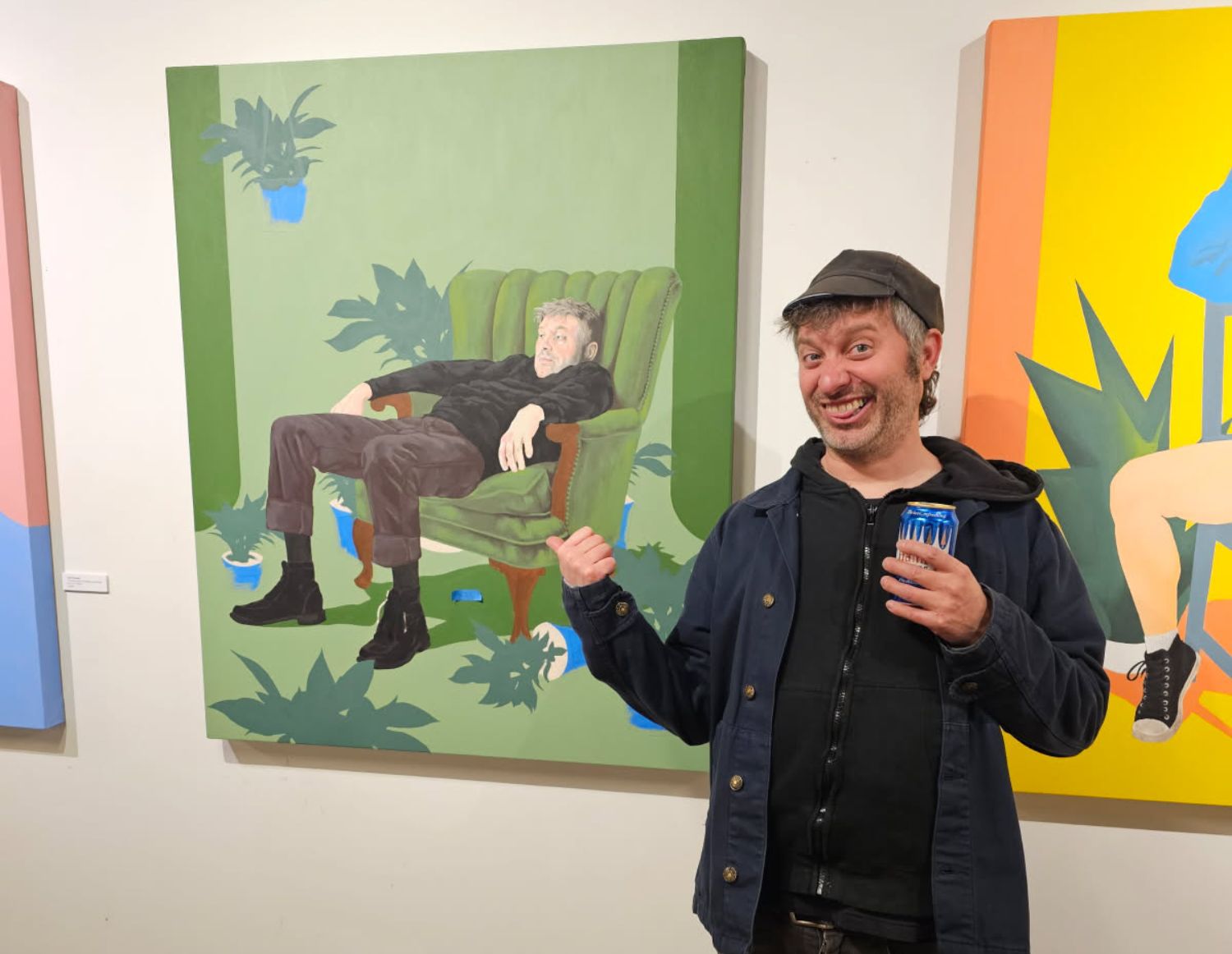
Sean Ferris posing in front of a painting from artist Russ White's Sitters series, for which Sean modeled.
We can't do it without you.
Help keep independent arts journalism alive in the Twin Cities.